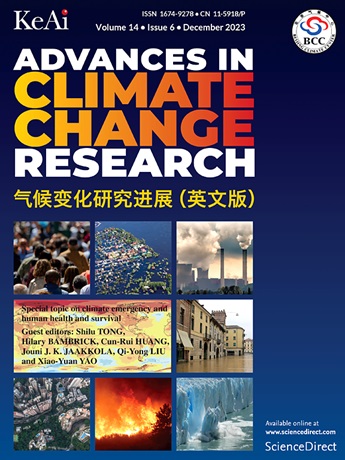Effects of solar radiation modification on precipitation extremes in Southeast Asia: Insights from the GeoMIP G6 experiments
IF 5.2
1区 地球科学
Q1 ENVIRONMENTAL SCIENCES
引用次数: 0
Abstract
Solar Radiation Modification (SRM) has been proposed to reduce global temperatures by reflecting more solar radiation into space, but its effects on precipitation extremes across Southeast Asia remain uncertain. This study evaluates the impacts of two SRM strategies on precipitation extremes in Southeast Asia, using the multi-model ensemble mean from five climate models in the Geoengineering Model Intercomparison Project Phase 6 (GeoMIP6). Under a high-emission scenario (SSP585), two SRM approaches are tested: injecting sulfur dioxide (G6sulfur) into the stratosphere and reducing the solar constant (G6solar) to maintain radiative forcing at the level of a moderate-emission scenario (SSP245). Bilinear interpolation and linear scaling were used to downscale and bias-correct daily precipitation data before calculating precipitation extreme indices, respectively. The results show that G6sulfur causes more regional variation in annual total and mean wet day precipitation, the average daily precipitation on days with ≥1 mm rainfall, compared to G6solar. In areas like central Borneo, northern mainland Southeast Asia, and eastern Indonesia, the annual maximum 1-d precipitation per year is projected to increase by 30%–50% under SSP585 relative to the historical 1995–2014 baseline period but this rise could be reduced to around 20% by SSP245, G6sulfur, or G6solar. G6sulfur has less influence on continuous wet and dry spells than G6solar, yielding results closer to SSP585. Both SRM strategies lower the projected increase in heavy precipitation days, except in areas like East Coast Peninsular Malaysia, Nusantara Indonesia, and East Timor. In conclusion, SRM may effectively mitigate increases in extreme precipitation events in most of Southeast Asia, but G6solar provides a more consistent reduction, while G6sulfur shows more complex spatial responses.
太阳辐射变化对东南亚极端降水的影响:来自GeoMIP G6试验的见解
太阳辐射调节(SRM)已被提议通过将更多的太阳辐射反射到太空来降低全球温度,但其对东南亚极端降水的影响仍不确定。本文利用地球工程模式比对项目第6阶段(GeoMIP6)中5个气候模式的多模式集合平均值,评估了两种SRM策略对东南亚极端降水的影响。在高排放情景(SSP585)下,测试了两种SRM方法:向平流层注入二氧化硫(g6硫)和降低太阳常数(G6solar),以将辐射强迫维持在中等排放情景(SSP245)的水平。在计算降水极端指数前,分别采用双线性插值和线性尺度变换对日降水数据进行降尺度和偏校正。结果表明:与g6太阳相比,g6硫对年总降水量、平均湿日降水量、≥1 mm日平均日降水量的区域差异更大;在婆罗洲中部、东南亚大陆北部和印度尼西亚东部等地区,与1995-2014年的历史基线期相比,在SSP585条件下,年最大1-d降水量预计将增加30%-50%,但在SSP245、g6硫或g6太阳能条件下,这一增幅可能会减少到20%左右。与G6solar相比,g6硫对连续干湿期的影响较小,其结果更接近SSP585。两种SRM策略都降低了预计的强降水日数增加,除了马来西亚东海岸半岛、印度尼西亚努沙tara和东帝汶等地区。综上所述,SRM可以有效缓解东南亚大部分地区极端降水事件的增加,但G6solar提供了更一致的减少,而g6硫则表现出更复杂的空间响应。
本文章由计算机程序翻译,如有差异,请以英文原文为准。
求助全文
约1分钟内获得全文
求助全文
来源期刊

Advances in Climate Change Research
Earth and Planetary Sciences-Atmospheric Science
CiteScore
9.80
自引率
4.10%
发文量
424
审稿时长
107 days
期刊介绍:
Advances in Climate Change Research publishes scientific research and analyses on climate change and the interactions of climate change with society. This journal encompasses basic science and economic, social, and policy research, including studies on mitigation and adaptation to climate change.
Advances in Climate Change Research attempts to promote research in climate change and provide an impetus for the application of research achievements in numerous aspects, such as socioeconomic sustainable development, responses to the adaptation and mitigation of climate change, diplomatic negotiations of climate and environment policies, and the protection and exploitation of natural resources.
 求助内容:
求助内容: 应助结果提醒方式:
应助结果提醒方式:


